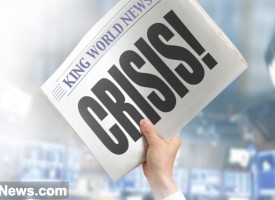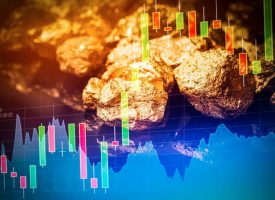As we kickoff a new trading year, this will be the biggest shock of 2017.
Stephen Leeb: “The most basic reason I am so bullish on gold and gold-related investments has to do with deep-seated inequalities and an aggressive push to address them. And no, despite the campaign rhetoric, I’m not talking about the U.S. or the incoming Trump administration, whose policies are largely inchoate. In fact, Trump’s evident plans to cut taxes before addressing the infrastructure gap here, and to slap tariffs on imports, constitute just the wrong medicine…
IMPORTANT…
To find out which company is set to become one of the
highest grade producing gold mines on the planet
CLICK HERE OR BELOW:
Rather I am talking about the world at large. You can divide our globe into two rough parts: West and East. The West has a population of about 1.5 billion people with per capita GDP of approximately $40,000. The East’s 6 billion people have per-capita GDP of about $4,000. That’s a big gap. But it has been steadily narrowing since the century’s start because of rapid growth in the East – courtesy largely of China – and slowing growth in the West. In the past decade and a half, annual growth in the U.S. has been 1.8 percent compared to 3.8 percent between 1949 and 1999. The picture is similar for the West as a whole: strong growth up to the beginning of this century and then a big fall-off.
 East Rising As West Declines
East Rising As West Declines
You could cite lots of reasons for why the East is now far outgrowing the West. But one fact stands out for me as particularly salient: between 1949 and the beginning of the century, commodity prices grew by less than 1 percent a year, while since 2000, despite all the volatility, they’ve risen by 3.8 percent a year. This has strongly benefited the East while being a drag on the West.
The East benefits in multiple ways from rising commodities. For one thing, it’s the major commodity producer – about 80 percent of oil production, the most important commodity, is in the East. More important, it has used commodities to build infrastructure, one of the surest ways to boost productivity and growth, and to build factories and cities that provide massive flows of goods sold to the West.
In a nutshell, the East has been able to grow despite rising resource prices because its ability to use resources to increase living standards has more than compensated for the higher prices of the resources it consumes. By contrast, the West has been paying higher prices for resources while failing to use them for productivity-enhancing infrastructure. As a result, the higher prices have simply operated as a tax holding back growth.
And the East shows no signs of faltering. While China’s own growth has slowed, China clearly recognizes its future growth depends on further development of the East. Hence the country’s One Belt One Road (OBOR), or Silk Road, initiative. China plans to initially spend $4 trillion on infrastructure for OBOR countries, which comprise about 70 percent of the world’s population and likely average less than $4,000 in GDP per capita. This comes on top of the $1 trillion a year China spends on its own infrastructure development. One upshot will be an East that is highly interconnected, with connections in some cases extending outward to resource-rich Western companies like Ecuador, Columbia, and Chile. A McKinsey study estimates a growth benefit of as much as 40 percent accrues to countries that are highly connected to others.
 West In A Do-Or-Die Situation
West In A Do-Or-Die Situation
Where does this leave the West? In a do-or-die situation. As far back as 1999 in my book Defying the Market: Profiting in the Turbulent Post-Technology Market Boom, I predicted the crash in tech stocks, but even more important, I argued our information technologies were inadequate to deal with resource scarcities, which I saw as our most pressing problem. So far, unfortunately, I’ve been right, and now China’s pursuit of OBOR ensures commodities will become even scarcer. But the U.S. still has its head in the sand.
A recent report by the American Society of Engineers (ASCE) is frightening in the context of a slow-growth economy. It estimates there is an infrastructure “gap” in the U.S. of more than $1.4 trillion, one that has been growing by about $35 billion a year. As a result, the report warns:
“From 2016 to 2025, each household will lose $3,400 a year each year in disposable income due to infrastructure deficiencies…If this investment gap is not addressed throughout the nation’s infrastructure sectors by 2025, the economy is expected to lose almost $4 trillion in GDP, resulting in a loss of 2.5 million jobs in 2025.”
To understand how an infrastructure gap contributes to such losses, think massive traffic jams on inadequate roads; bridge closings; blackouts, and so on.
Incidentally, the 30-page report had no mention of China – i.e., this is the projected price tag without taking China into account. But China is lurking in the background, not because it is beating us in trade but because its own development and the development it will spur throughout the East will keep commodity prices rising, likely at an accelerating pace.
The sooner we face this, the better. Cutting taxes before we address the infrastructure gap is putting the cart before the horse in a big and doomed-to-fail way. A tax cut may spur growth, but it’s growth that won’t come with productivity gains. Absent investment in infrastructure, living standards won’t increase, and inflation will likely suck up more than every dollar the typical worker gains in wages.
 China’s Ghost Cities Becoming MegaCities
China’s Ghost Cities Becoming MegaCities
China understands that commodities are scarce and getting scarcer, as its initiatives show. Remember all the talk about China’s ghost cities? You don’t hear much of that any more. Why? Because those ghost cities are becoming parts of megacities. The Yangtze River delta area, where Shanghai is the major city, is expected to grow from 170 million people to more than 250 million in the late 2020s. These dense megacities will allow major commodity savings and higher worker productivity, thanks to ultra-fast trains, the need for fewer water pipes and electric wires per person, greater accessibility of hospitals, and much more.
So yes, China is indeed a massive threat, not because of trade but because it is committed to narrowing the 10-fold gap between the world’s rich and poor. While Trump supporters have celebrated his election as a catalyst for U.S. infrastructure building and concomitantly higher productivity and rising living standards, I’m worried that if instead of infrastructure we first get a tax cut and/or a trade war, the ASCE will likely be right and then some. This would not have a happy ending for the West.
 The Will Be The Biggest Shock Of 2017
The Will Be The Biggest Shock Of 2017
Now for the investment implications. Many scenarios suggest we’ll get deflation, possibly the result of another 2008-like crisis – always a boon for gold. China will likely accelerate its OBOR strategy with the help of a gold-based monetary system. The world could end up fracturing into the East, still relatively poor but getting richer very quickly, and a once-rich West being overtaken by the East. The most coveted asset in virtually any scenario that I can think of will be gold, which will be either a haven in a deflationary storm or the only means of buying ever scarcer commodities. Either way, gold is headed far higher.” …KWN has now released the remarkable audio interview with the man who advises the most prominent sovereign wealth funds, hedge funds, and institutional funds in the world and you can listen to it by CLICKING HERE OR ON THE IMAGE BELOW.
***KWN also released one of Marc Faber’s greatest audio interviews ever and the overseas line was crystal clear for the recording. Faber covers the great danger facing the financial system in the coming year, what his predictions are in 2017 for global markets, stocks, bonds, gold, silver, mining shares, etc, what investors should be doing with their money right now, what has the wealthy so worried in 2017, how Trump will impact major markets, and much more, and you can listen to it by CLICKING HERE OR ON THE IMAGE BELOW.
***ALSO JUST RELEASED: Looking To Hit It Big In 2017, Take A Look At What This Top Global Advisor Just Said CLICK HERE.
© 2017 by King World News®. All Rights Reserved. This material may not be published, broadcast, rewritten, or redistributed. However, linking directly to the articles is permitted and encouraged.










